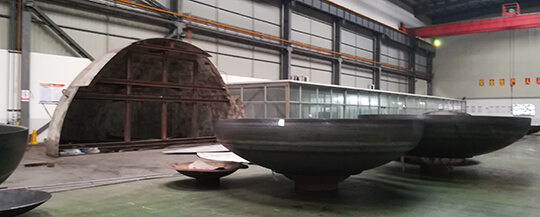When the dual-phase composite plate head is cold-formed, the surface of the cladding after pressing will always leave scars, and the local thickness will be reduced, especially near the R transition area. The repeated rolling of the cladding is also prone to wrinkles. If the composite board is defective during explosive compounding, the cladding is easily peeled off. In addition, the cladding dual-phase steel material has high strength and high hardness, low thermal expansion performance, and the yield strength is twice higher than that of ordinary stainless steel. Moreover, it has sufficient plasticity and toughness during molding, and cold molding is generally difficult to control the size.
When the dual-phase steel composite plate head is thermoformed, the heating temperature and holding time are generally strictly controlled. After molding, it should be cooled quickly to minimize the high temperature embrittlement caused by the precipitation of the σ phase at 500~925℃and the 475℃embrittlement caused by the precipitation of the α'phase at 400~500℃. The production of these two phases will affect the toughness of the steel, and the local corrosion resistance will decrease, which is detrimental to the corrosion resistance of the material. The coated duplex stainless steel of the head is designed to be corrosion resistant. Therefore, the mechanical properties of the material, the corrosion resistance of the coating and the geometric size of the head are difficult to guarantee and meet the standard requirements during the manufacturing process of the head, which will inevitably bring difficulties to the manufacturing of the head. According to the previous manufacturing experience of composite plate material heads such as SA-516-Gr.70+SA-240-304L and the recommendations of the head manufacturer, if the composite plate head is integrally formed, it is best to choose a hot press type. The forming method of the composite plate head adopts hot pressing, and a test plate is brought into and out of the furnace at the same time as the head plate, and sprayed and quickly cooled immediately after forming to avoid the precipitation of brittle phases. Perform physical and chemical tests on the furnace test panel to verify whether the mechanical properties and corrosion resistance of the composite panel material are damaged during the hot pressing process.
